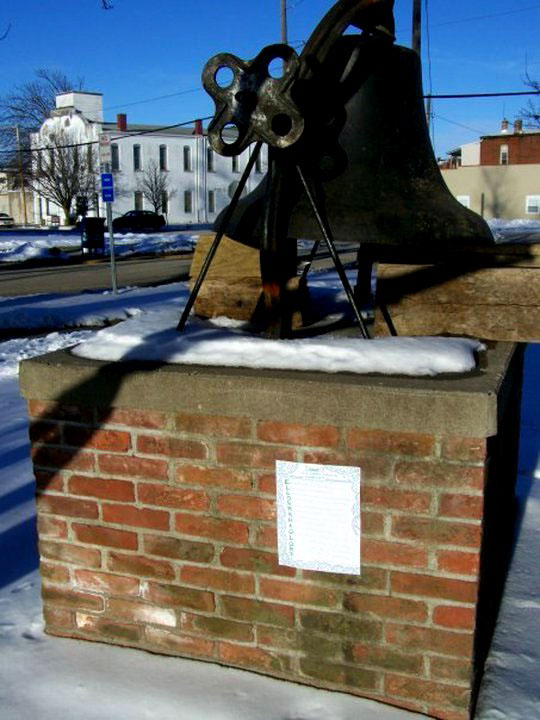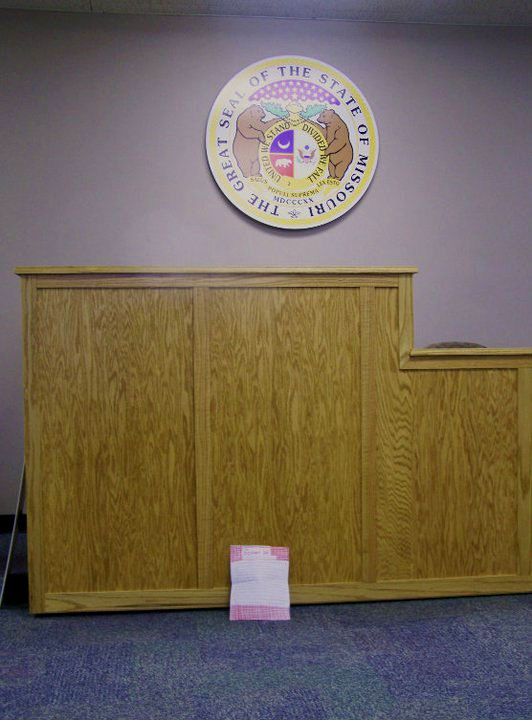This project was a way of honoring Marilyn Nelson's book "A Wreath for Emmett Till". Her book is a heroic crown of sonnets (linked sonnets) about the life and death of Emmett. I copied the sonnets out of her book and re-wrote them on decorative paper to be distributed throughout Canton, Missouri. I photographed each sonnet in the specific locations to show a relation between the poem and its environment. The project began February 14, 2010 and ended May 6, 2011.

Sonnet #1. "Rosemary for remembrance Shakespeare wrote."
I placed the first sonnet in a restroom because I wanted the verses to come "suddenly" at the reader. I remember when I first saw the book "A Wreath for Emmett Till" and how very surprised I was. I had a deep fascination about Till and had never come across a children's book about it. I immediately gained a deep appreciation of the book and I wanted it to enter into another person's life as unexpectedly as it entered mine.

Sonnet #2. "Forget him not, though if I could, I would."
Around this time I was not taking into consideration the location of the sonnets in relation to the poem. However, that changed as the project continued.

Sonnet #3. "Pierced by the screams of a shortened childhood."

Sonnet #4. "Emmett Till's name still catches in my throat."
By the time I did sonnet four, I realized that I should make the poems relate to their environment. In this sonnet, Marilyn Nelson writes about Emmett Till getting on the train to go from Chicago to Mississippi. I decided to go to the train tracks in Canton, Missouri and place the sonnet on a stop sign. The tracks are by the Mississippi. I read in Mamie Till Bradley's (Emmett's mother) book about him and she said she did her best to tell him how to act around whites in the South. She was afraid that because he was from a big city he was not properly equipped to deal with such a level of racism outside of his usual setting. I was glad to see that Marilyn Nelson also included that Emmett was a stutterer. He had suffered from polio as a child and this left him with a speech impediment. When he stuttered over words, his mother told him to whistle to get his words out. He had particular trouble with the letters "B" and "M". On that fateful day when he encountered Carolyn Bryant (the woman who accused him of wolf whistling at her) he had purchased bubblegum.

Sonnet #5. "Your only child, a body thrown to bloat"
Down the hill from my college, there is a Catholic Church with a statue of the Virgin Mary. I felt this was the most appropriate place to leave the fifth sonnet. Marilyn Nelson compares Mamie Bradley to Mary for both of their sons were innocent martyrs by hateful hands. When 14 year old Emmett was brutally lynched (a mixture of beating, gun wound, etc) he was tied with barbed wire to a cotton gin and thrown into the Tallahatchie River. Many people assumed that he was castrated which was habitual of most lynchings, but his mother confirmed that he was not. When found by a young white male in a boat, Emmett had been floating in the Tallahatchie River for three days (as Christ resurrected after three days). His mother stated that he had been shot, I believe in his right temple, his eye gouged out, another hanging from a socket, most of his teeth were missing, his head seemed to have been hacked as well, among the list of inhuman cruelties done to this innocent child. The reason he floated to the top of the river was because they did not tie down his feet. His body was so bloated that he hardly looked human at all. The only form of identification was the ring on his finger. It had belonged to his father Louis Till, who died in the military when Emmett was a small child. Emmett used to put tape on the ring to make it fit, but right before his trip, the ring fit without tape. Mamie briefly considered suicide after learning of her only child's death. However, she gained spiritual solace and used that comfort in order to gain justice for her son.

Sonnet #6. "Mutilated boy martyr, if I could"
I chose the All Faiths Chapel at my college for this sonnet. Marilyn Nelson writes of placing Till in a parallel universe and allowing him to live a happy life. I felt that this chapel was the ideal place for contemplation and I left it sitting there for days and days

Sonnet #7. "Erase the memory of Emmett's victimhood"
In this sonnet, the author decides to give Emmett a full, ideal life and gives him different lives to live
speaking. I chose this bell because it is commemorating something great in the town, just as Nelson is
commemorating Till.

Sonnet #8. "The memory of monsters, that bleak thought."
Marilyn writes of a horror film and suddenly the reader realizes that Till's lynching is a nightmare made real. I placed this sonnet at the Lewis Street Playhouse because it is the town's movie theater.

Sonnet #9. "Tears, through the patchwork drapery of dreams"
I went to the Mississippi to throw the sonnet in the river so it would float away. This sonnet is remembering those men and women of Afrikan descent who were lynched. I felt that placing the sonnet in the river was a way of making a libation statement (paying homage to ancestors) Unfortunately, it was extremely frigid out and the sonnet landed in the snow instead of the river. However, I believe it made it after all.

Sonnet #10."Let me gather spring flowers for a wreath."
I found these flowers on campus and left the sonnet there. This sonnet is talking of gathering various flowers for an wreath in honor of Till. Each flower has its own meaning and formed together, they create their own language.

Sonnet #11. "Trillium, apple blossoms, Queen Anne's lace"
I placed this sonnet beneath a tree because it speaks of lynching trees. There were numerous lynchings all over the country, some announced in newspapers and others done secretly. Some believe that lynching was merely hanging from a tree, but it could range from castration, public rape, mutilation, gun shots, stab wounds, beathings, being set on fire, etc. Many people lynched were merely ashes at the end of it, their body part placed on display or sold in local stores. Such horrible things are recorded by nature: the trees hold all of the stories.

Sonnet #12. "Indian pipe, bloodroot. White as moonbeams"
I placed this sonnet in some obscure stream to represent how Till's body was merely discarded as if it were nothing.

Sonnet #13. "Like the full moon, which smiled calmly on his death."
I thought the first line of this sonnet was powerful. I placed the sonnet on the big hill at our school because the moon shines on it at night and you can see all of the stars. I took it during the daytime because I did not want to wait until nighttime.

Sonnet #14. "Like his gouged eye, which watched boots kick his face"
Once again, a very strong line. This sonnet speaks of standing up against injustice and the atrocities done to other people. Nelson even does a psychological evaluation of lynchers: they lynch because they fear themselves and they fear their victims. I placed this sonnet in a mock courtroom at my college and hid it so the sonnet would not be thrown away.

Sonnet #15. "Rosemary for remembrance, Shakespeare wrote."
This last sonnet is the final one and combines the first lines of the previous sonnets to stay in the theme of a "heroic crown of sonnets" (Petrarchan, to be specific). I left this sonnet in the outdoor chapel because it is the most peaceful place I could find on campus. Nobody goes there very much and I left the sonnet at the Cross, in the middle of spring. I felt that it was a beautiful ending to my project and felt very appreciative.

R. I. P. Emmett Till


